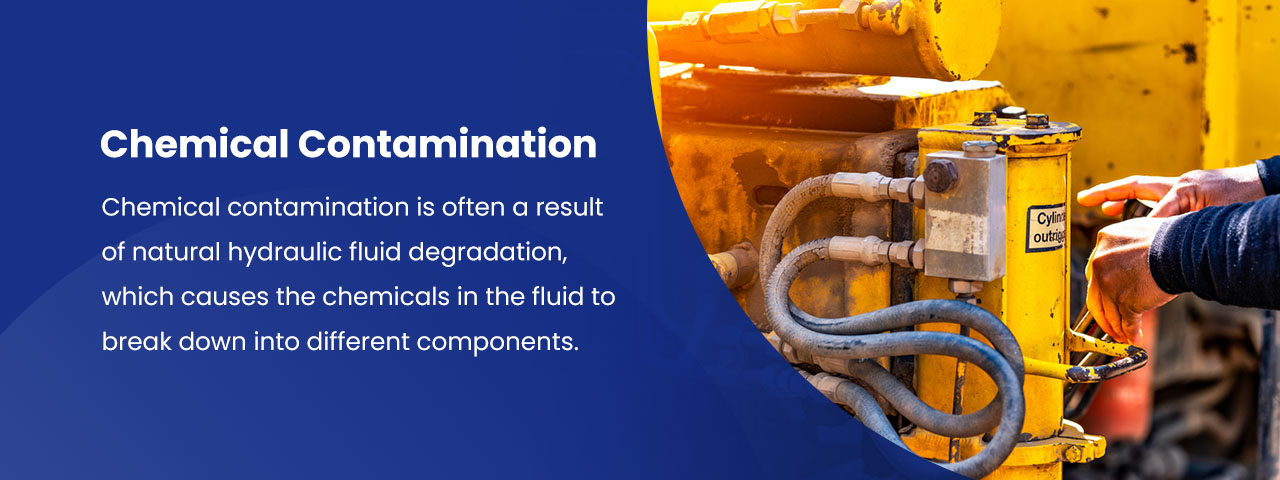December 27, 2024
Common Contamination in Hydraulic Systems
While hydraulic systems are incredibly efficient, they are prone to contamination by a wide variety of substances from the point of manufacturing to the point of usage. Some of the system issues that result from contamination include hydraulic system failures, leakages, hardware damage and degrading of hydraulic fluid.
Contamination in the system negatively impacts efficiency and productivity and decreases downtime. Below, we discuss the most common sources of contamination in hydraulic systems to make it easier to identify and handle them before they cause extensive and permanent damage to the system.
1. Built-In Contamination
Often, you purchase an already contaminated hydraulic system. Built-in contamination happens during the system’s manufacturing or assembly process. Contamination during system production can result from:
- Residue
- Metal shavings
- Weld spatter
- Cleaning cloth fibers
- Excessive grease during assembly
Built-in contamination can also occur during the production of the hydraulic fluid due to the entry of contaminants during processing or mixing.
To prevent the effects of built-in contamination, flush the system whenever the machine undergoes an overhaul or when installing new components. You should also rinse new components using fresh hydraulic fluid to remove contaminants on the surface of the new parts. Attaching a high-quality filtration system to the hydraulic pump also prevents built-in contamination by barring contaminants from entering.
2. Water Contamination
Water contamination can occur when moisture seeps into the system due to leaks or forms inside due to condensation caused by temperature changes. Moisture gives the hydraulic system a milky appearance and can react with additives in the fluid to cause problematic chemical reactions. Operating a hydraulic system in a humid environment makes it more susceptible to moisture contamination.
Moisture results in a myriad of issues, which include:
- Oxidation and freeze damage.
- Corroding internal hydraulic system components.
- Reducing the fluid’s elasticity and performance.
- Increasing the risk of cavitation in the machine’s pump.
- Decreasing the lubricating properties of the hydraulic fluid.
- Reducing the fluid’s compressibility and efficiency.
You can prevent water contamination by always keeping hydraulic fluid sealed tight to prevent it from absorbing moisture.
3. Chemical Contamination
Chemical contamination is often a result of natural hydraulic fluid degradation, which causes the chemicals in the fluid to break down into different components. The degradation may also be caused by excessive heat and pressure. The different secondary chemicals mix and react, causing contamination that accelerates wear and tear in various system components.
You can prevent chemical contamination by not mixing different types of hydraulic fluids. It’s also good practice to always confirm and stick with the hydraulic fluid recommended by the manufacturer. Remember to check the recommended replacement date for the fluid and adhere to those timelines. Additionally, always flush out old fluid completely before adding fresh fluid and filter it before adding it to the system.
4. Ingressed Particulate Contamination
Ingressed particulate contamination is caused by sand, mud, dirt, metal flakes and dust particles entering hydraulic systems. These particles enter the system through leaking seals or when the system is opened during repair and maintenance.
It can result in the failure of hydraulic motors and rods in the pump by scouring them to reduce hydraulic system efficiency. Another effect of ingressed particulate contamination is damaging internal seals, making them loose, which allows more dirt and moisture to enter the system.
The abrasive particulate contaminates the hydraulic fluid, causing a wide range of issues in the hydraulic system, including:
- Formation of vapor-filled cavities
- Increased risk of cavitation
- Failure or malfunction in the hydraulic system
This type of contamination can be prevented by promptly replacing leaking seals and ensuring the system is only opened in a clean environment. Regular preventive maintenance that involves cleaning the equipment and replacing hydraulic fluid filters can minimize the risk of ingressed particulate contamination.
5. Generated Contamination
Generated contamination results from general wear and tear of the hydraulic system, which is expected to occur with time and age. As the hydraulic parts move, they generate fine, abrasive grit or degraded rubber and polymer seals that contaminate the fluid. It’s more common during the initial equipment break-in phase and when the parts are not sufficiently lubricated, which may be caused by leaks or the wrong fluid choice.
Your system continuously generates contaminants as it runs, which can result in clogged parts, stuck valves and other issues that affect the flow and pressure of the hydraulic fluid. You can remove leftover particulate matter by flushing new equipment or replacement parts. Using the right filters and replacing them regularly can help to eliminate generated contaminants, keeping the system functioning effectively.
Other Ways to Keep Out Hydraulic System Contaminates
While there are many ways to prevent hydraulic system contamination, some general practices prevent many types of foreign substances from entering the system. Some of these tips include:
- Select the right hydraulic fluid for your system.
- Carefully store and transport your hydraulic fluid.
- Avoid reusing hydraulic fluid.
- Keep work areas and equipment clean using lint-free rags.
- Regularly inspect the hydraulic system for signs of contamination.
- Check the system for leaks and repair them promptly.
- Change and clean filters regularly to prevent clogging, which impairs their efficiency.
- Keep an accurate and updated maintenance schedule and report.
Reach Out to Chase Filters & Components
Chase Filters & Components is a leading industrial and commercial filter manufacturer with over 30 years of experience. We offer a variety of high-quality filters for eliminating air, water and particulate contamination from different types of hydraulic machinery. Our filters help increase performance and production efficiency and reduce component replacement needs.
Our filters will save you time and costs associated with maintenance, repair and replacement of hydraulic system parts damaged by contamination. Contact us today to learn more about our filters or browse product pages to find the right filters for your specific application.


